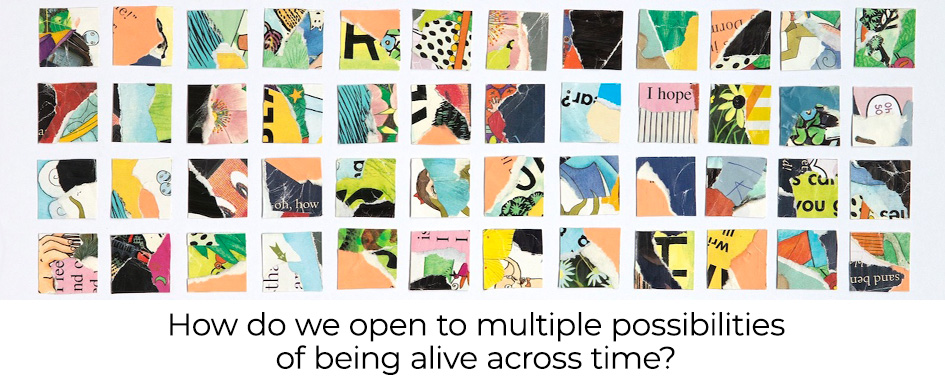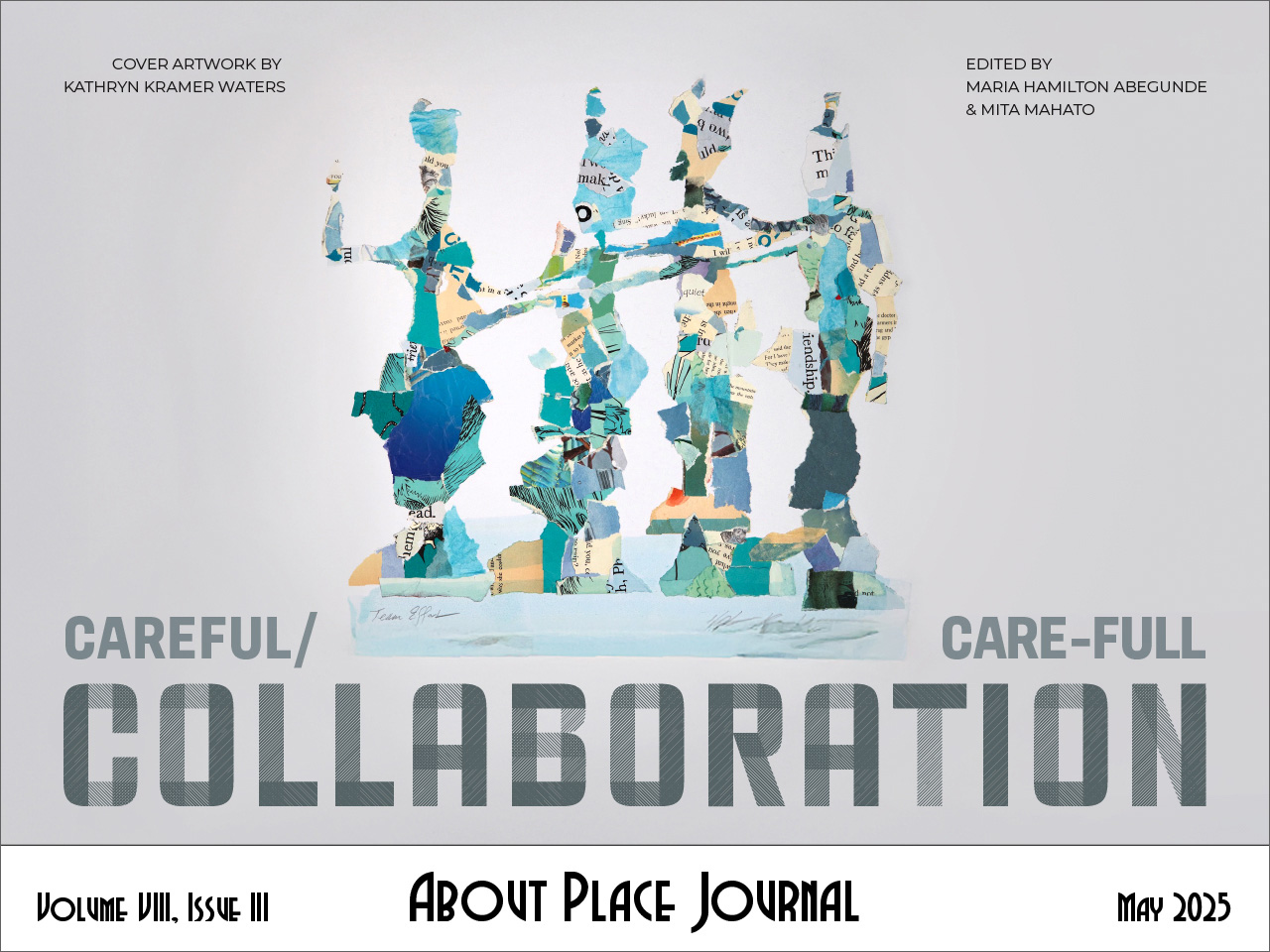On a humid Tuesday morning in March, fifteen women held hands in a circle with their eyes closed and evoked the protection of ancestral spirits as they began the work of the MASK-WE project.
For the next six weeks these women learned about Igbo and Mexican artisanal arts, and reinvented the Igbo masquerading mask. Through the process of creative collaboration, each woman took possession of a wooden mask on which to inscribe her story using vibrant colors, and ancient symbols and images. Their imagination on full display, the women with each brushstroke, erased generations of reasons for their exclusion from the most powerful and secret tradition of their clan, and through a growing relationship with the mask, they communed with ancestral spirits. Their relationship with the mask conferred upon them, the right of access into the spirit hut. At the end of the six weeks, their beautifully adorned masks confronted centuries of marginalization to provoke dialogic exchanges about the power structure in Igbo society and gender politics.
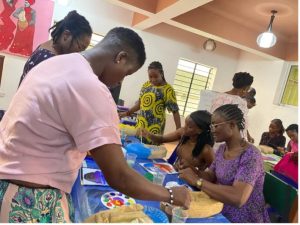
It was years earlier when the idea behind the MASK-WE project was conceived. I was sitting with a group of women recounting an incident earlier in the day that took me back to an even earlier recollection of the story of a young woman buried alive under a pyramid. It was my first visit to my father’s birthplace, where an uncle took me to the village square and pointed to the leaning mud pyramid “the woman disguised herself as a man to go and enjoy the spectacle of the masquerades at the square. Soon the men smelled her womanhood and exposed her deceit.” He continued “that is the monument erected over her, alive, as her punishment.” The pyramid leaned adjacent to the shrine of Ugwu, the ancestral father of Imezi Owa, a community a few miles from Enugu. Ugwu, his wife and child sat imposingly on their thrones gazing towards the square. It was a position they had held for millennia during which their fixed, stone, watchful eyes protected the community. Nothing escaped them.
The women and I were sitting under the tattered, faded patio umbrella at the center of a shady mango grove. It was a clear night illuminated by a million stars, giving enough light to see the green mangoes hanging from the expectant trees. The impatient bats screeched in the thick foliage of the trees gnawing at the green fruits. The night air was still and oppressive. It hadn’t rained in many months and the air weighed heavily in anticipation of the next rainfall.
It was Enugu in February!
That afternoon, I had taken a public Tuk-tuk to Ogbete market, the biggest market in southern Nigeria. I wanted to buy souvenirs for my return trip to the United States. I was in Nigeria to research the Igbo presence in Cuba and other Caribbean nations thanks to the singular work by the North American scholar, Ivor Miller on how Africans transported to the Americas during the transatlantic slave trade brought their knowledge about political fraternities and how these fraternities played a formative role in the history of Cuba for example. The Cuban Abakuá had antecedents in the Ekpe secret society practiced by several ethnic groups in southern Nigeria. My research was about the roles Igbo women and other ethnic groups might have played in foregrounding the Ekpe/Abakuá secret societies.
It is said that you can buy anything at Ogbete market, and the “anything” typically harbored a sinister undertone. The heat in the afternoon was made even more oppressive by the sheer number of people at the market. The vendors’ calls to potential customers clashed with music blaring from mobile speakers to create a sonorous chaos. I ignored the calls and made my way to the section of the market that sold artisanal products. I paused briefly under a tin roof covering the corridor to the section of the market that was my destination. The sweat continued to drip from my face, arms, and run down the small of my back. To the left and right of the corridor were rows of stores that sold artifacts, from gongs, drums, shekeres, koras, charms, bells, whistles, figurines, dolls, to masks that spoke collectively of ancestral practices. As the crowd pushed me along the dark, narrow, corridor, I noticed a store with a display of drums at the entrance. The store owner noticed me too. “Madam, come and price it” he beckoned. There were beautiful Udus, portable slit drums, different sized Igba talking drums, and the Ogidi drum. I had learned that many indigenous musicians prefer to play the Ogidi drum to the accompaniment of the Igba. The Ogidi is a big, cylindrical drum, and drummers typically will stand to play it effectively. “How much last?” I asked him, pointing to the Ogidi and trying to disguise the fact that I’d been away from Nigeria for many years. My foreignness was sure to make the Ogidi drum expensive. The store owner gave me a price –it is always good practice to never accept the first price given and to haggle until you are satisfied with the cost price. The truth was that the Ogidi was too big to be a portable souvenir, but I welcomed the stop in front of the store to give me time to cool down. The gentleman saw how sweaty I was and gave me a raffia akupe to fan myself.
I looked away from the Ogidi drum to locate a more practical purchase. The store was crammed with an assortment of musical instruments, masquerading costumes, red chieftaincy hats, bastons, cowry and coral beads, and masks. There were different kinds of wooden masks, some were adorned, and others appeared hurriedly carved. A large wooden mask that had the grotesque appearance of a gargoyle was on a top shelf partially covered with a dusty red velvet fabric. The carved mouth was unfinished, and it was missing a horn. The finished eyes of the mask returned an eldritch stare reflecting the secrets of ancestral spirits. “How much is that”? The storeowner turned slowly to look in the direction of my eyes as though he already knew what I was pointing at, and how he would respond, “Madam, we do not sell masks to women. If you wish to buy the mask, you will need to return with your husband who will buy it for you.”
A bat screeched in unison with one of the women’s incredulous remarks. “Nonsense” she lamented. “How can this happen in the twenty-first century? It’s not like you were asking to be a masquerade. I don’t understand why he would not sell you the mask. And you do not even live in Nigeria”. For the next few hours, we discussed the role of women in Igbo society and railed against her exclusion from certain traditional practices. I wondered quietly why the young woman buried alive under the pyramid would pay with her life for seeking knowledge, and how her abortive effort continued to impact women today, clearly a reason why I was prevented from buying a mask. “What can we do, what should we do?” I asked, taking a sip of Zobo from the plastic cup in my hand. One of the women recalled the role of women as represented in Chinua Achebe’s novel Things Fall Apart and wondered whether modern Igbo society was suffering the effects of a religious-political imposition by the British colonial enterprise. That night, we had a lot of questions with few answers.
In Achebe’s novel set in a quintessential Igbo village during the early twentieth century, masquerades or egwugwu served as arbiters of justice because their decisions were sacred and final. On the occasion of a judgment that involved Uzowulu, an abusive husband whose wife returned to her parents’ home because of his incessant beatings, the egwugwu emerged from the spirit hut, summoned by the sound of the gong. While the men of Umuofia were seated to greet the masquerades, the women and children stood at a safe distance ready to run if the masquerades came too close:
An iron gong sounded, setting up a wave of expectation in the crowd. Everyone looked in the direction of the egwugwu house. Gome, gome, gome, gome went the gong, and a powerful flute blew a high-pitched blast. Then came the voices of the egwugwu, guttural and awesome. The wave struck the women and children and there was a backward stampede. But it was momentary. They were already far enough where they stood and there was room for running away if any of them should go towards them. The drum sounded again and the flute blew. The house was now a pandemonium of quavering voices: Am oyim de de de de! filled the air as the spirits of the ancestors, just emerged from the earth, greeted themselves in their esoteric language. The egwugwu house into which they emerged faced the forest, away from the crowd, who saw only its back with the many-coloured patterns and drawings done by specially chosen women at regular intervals. These women never saw the inside of the hut. No woman ever did. They scrubbed and painted the outside walls under the supervision of men. If they imagined what was inside, they kept their imagination to themselves. No woman ever asked questions about the most powerful and the most secret cult in the clan. Am oyim de de de de! flew around the dark, closed hut like tongues of fire. The ancestral spirits of the clan were abroad (Achebe 1958, 70).
The women of Umuofia were excluded from the masquerading tradition, and even those that were especially chosen to adorn the spirit hut remained on the outside, lacking knowledge of the most powerful oracle of their clan. My response, or lack thereof at Ogbete market was the absence of knowledge about women and the masquerading tradition. For long, Igbo women’s approximation to their cultural practices was only if the men gave their permission. Women may have been curious, and even on occasions defied cultural beliefs and the power structure, but for generations, women’s imaginations, like those women in Umuofia took them only as far as the door. They never went inside the spirit hut. They never engaged with ancestral spirits.
That evening, we understood that the answers to our many questions lay in the symbolism of the mask. The mask was an artifact central to the masquerading tradition among the Igbos, and when worn by men, indicated their transformation into ancestral spirits and deities. Simultaneously, the mask represented exclusion, and castigation of women whose curiosity and imagination attempted to reveal the secrets behind the mask. Like the spirit hut, the mask represented the intersection between the terrestrial and spiritual realms, the intersections of knowledge and power, and between the present and past, and while the expertise of certain women allowed them to adorn the exterior of the spirit hut, they were prevented from the knowledge of the mask. There was also the realization among us gathered under the starry night, that often, when bestowed with knowledge about the mask, women acted like the women in Achebe’s novel who preferred to keep their knowledge and imagination to themselves. That night, we resolved to appropriate the Igbo mask and reinvent it with our histories, our new knowledge, our relationship with our ancestors, our agency, and our love for art. The mask would give us access to the spirit hut.
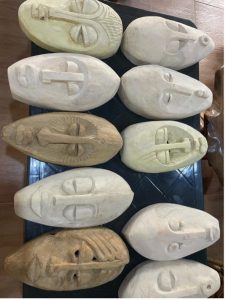
The MASK-WE concept involves taking a wooden mask and adorning it with vibrant colors, symbolic designs, and the interpretation of the world according to women, written using the Nsibidi and Uli ancient systems of communication. Like the enslaved Africans who centuries before carried the Nsibidi and Uli ideograms and symbols across the Atlantic Ocean, and inserted them into a New world cosmovision, the women imagined the MASK-WE as a sororal community, secretive, with the purpose of self-awareness and as a mode of access to the ancestors and deities. The MASK-WE, like the Cuban “Anaforuana”[1] would serve as a new identifier of African womanhood, and become a site for sociocultural and political discourse, and pathway to discovering the answers about the most powerful manifestation of ancestral spirits among the Igbos.
To reinvent the Igbo mask, the MASK-WE project contemplates three artistic traditions: Igbo women and body art, the masquerading tradition as the exclusive preserve of Igbo men, and the Mexican alebrije.
According to the Nigerian folklorist, Regina Igbo, Igbo women used body art to mark significant milestones in a woman’s life –from her first menstrual episode, to marriage, to her pregnancies, to taking on an important position in the community and so forth. In early times, a young woman who experienced her first menstruation would begin a regime of beautification in anticipation of her future betrothal. The matriarchs of the community would use the red dye of the camwood to smoothen her skin and the grey-black dye of the Uli seed to tattoo her face, her abdomen, and legs. This would go on for months until the women were satisfied with the result. The young woman, clad only in the traditional “jigida” made of strings of red coral beads that draped around her hips, paraded through the village with the expectation of a suitor. She was ready to begin the next stage in her life as a wife and mother.
Masking in performative art is ubiquitous in many African cultures. Among the Igbo ethnic group, men masquerade during important communal celebrations like harvests, coronations, burials, arbitrations, and battle victories. In Things Fall Apart, the narrator refers to masquerades as egwugwu whose emergence into the public space is through the spirit hut. Egwugwu typically cover their faces with masks made of wood or fabric, and wear full body suits made of wool, raffia or jute. Their performance marked by sudden, frenzied outbursts elicit joyous approval from the men, and a mix of curiosity and terror from the women and children. Egwugwu are ancestral spirits, and their entrance and departure from the terrestrial realm is a secret held only by men.
In Mexico in the early twentieth century, the fevered dreams of Pedro Linares cast fantastical figures which he named alebrijes. Recovered from his illness, Linares began to represent the creatures of his hallucinations using cardboard and papier mâché and painted them with vibrant, contrasting colors. Since then, alebrijes have garnered local and international fame, and in the region of Oaxaca in southern Mexico where alebrijes are carved from the wood of the copal tree, their production has excelled. In general, the production of alebrijes comprises shared responsibilities where men carve the figures, and women do the painting.
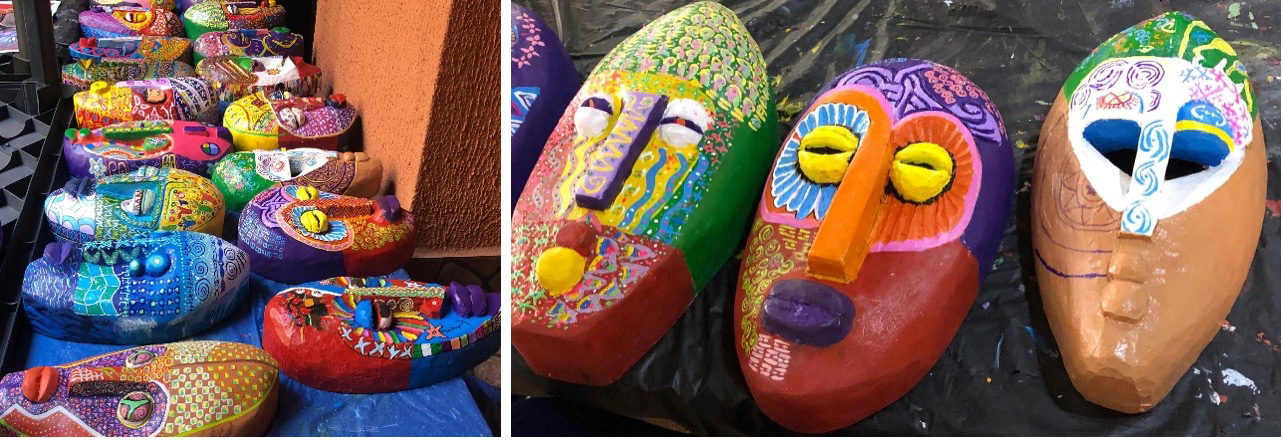
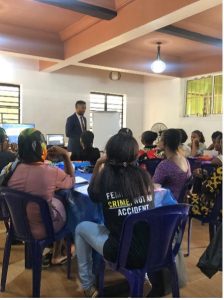
Today, engaging with ancestral spirits through the MASK-WE project assumes an important role as purveyor for women’s economic empowerment operation. The women and I who sat under the patio umbrella one night understood that in a region in west sub-Saharan Africa where women and girls remain a critical underserved population, that the knowledge production of the mask could be put to good use to provide the skills and resources for women to transform them into productive citizens. As such, we structured the MASK-WE project into a skills training and revenue earning program that nurtures and encourages participants to become independent and financially stable women.
I dream, and I see the young woman lift towards the sky, a beautifully painted mask. She looks heavenwards through the eye slits of the wooden mask, and slowly, lowers the mask to her face. The Igba drum speaks in the distance…
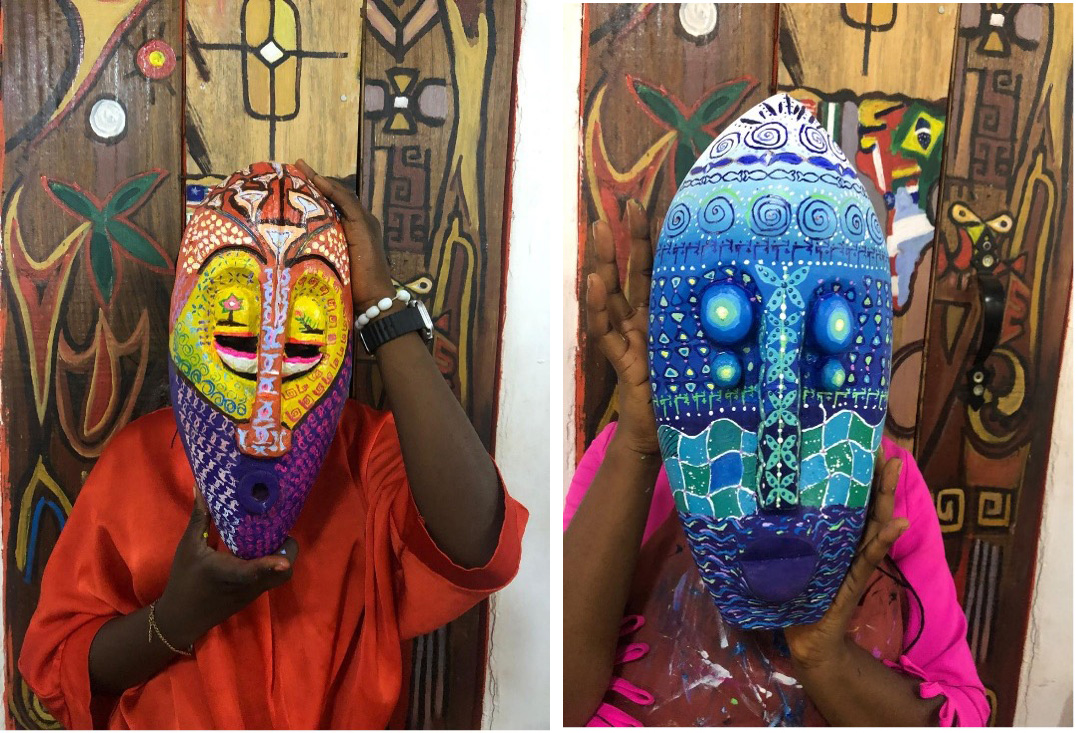
[1] Anaforuana is a reference to the collection of symbols in the Abakuá secret society in Cuba. It is also a reference to a book title written by Lydia Cabrera.
References
Achebe, Chinua. 2008. Things Fall Apart. Introduction by Mpalive Msisk. Heinemann.
Benhabib, Seyla. 1992. Situating the self: Gender, community and postmodernism in contemporary ethics. New York: Routledge.
Cabrera, Lydia. 1975. Anaforuana: Ritual y símbolos de la iniciación en la sociedad secreta Abakuá (Los de hoy). Ediciones R; Tapa blanda edición.
Gillman, Laura. 2013. “Narrative as a Resource for Feminist Practices of Socially Engaged Inquiry: Mayra Montero’s In the Palm of Darkness.” Hypatia, Vol. 28, No. 3 (Summer): 646-662.
Igbo, Regina. 2016. “Tales from Egede.” Lecture, Salem College, Winston-Salem, NC, April 8.
Miller, Ivor, L. 2009. Voice of the Leopard. African Secret Societies and Cuba. The University Press of Mississippi/Jackson.

